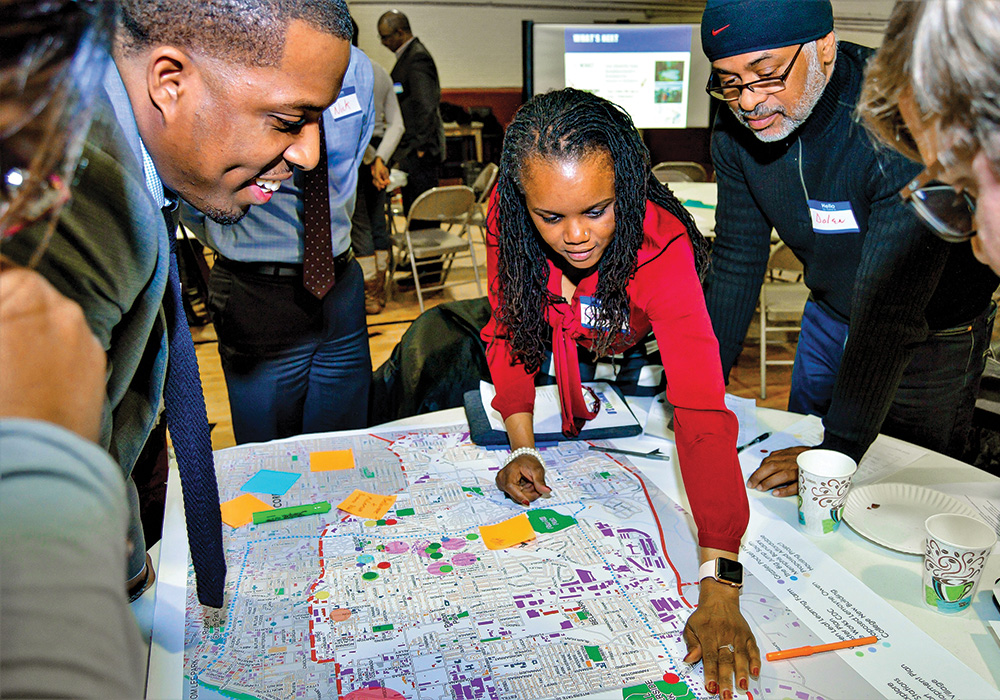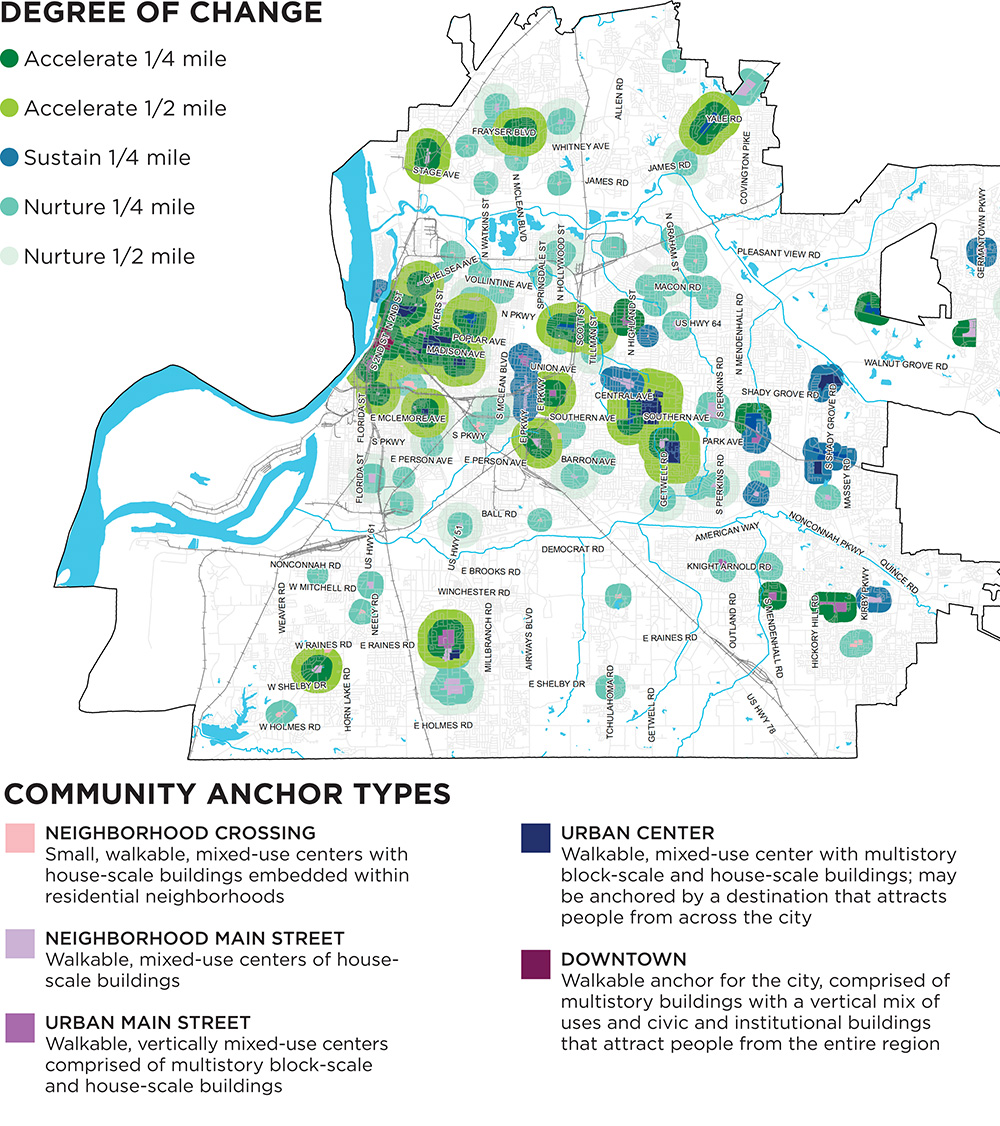Planning May 2020
Daniel Burnham Award for a Comprehensive Plan
Memphis Makes the Case for Planning
Memphis 3.0 Comprehensive Plan | Memphis, Tennessee

Residents of the South District neighborhood map out assets, challenges, and opportunities for new growth in the first of three planning workshops for each district. Photo courtesy City of Memphis.
By Linda McIntyre, AICP
Founded in 1819, Memphis, Tennessee, is well known for its vibrant music and food scenes and its central role in civil rights history. It has some prime examples of innovative adaptive reuse, such as the Crosstown Concourse — a LEED Platinum mixed-use makeover of a 1927 Sears distribution center — and great recreational spaces like Shelby Farms Park, with its bike and pedestrian Greenline trails.
But for nearly 40 years, Memphis (pop. 650,000) overlooked many of its core neighborhoods, including the downtown district and the areas around its universities and hospitals, in favor of growth. The city's last comprehensive plan, Memphis 2000, adopted in 1981, focused investment outward, resulting in aggressive physical expansion through annexation and suburban sprawl. Since that time, the city has expanded by almost 100 square miles, to a staggering 340 square miles — but without population growth.
"As the responsibility to provide services expanded across a spreading city, public safety absorbed more and more of the city's budget, while money left for parks and infrastructure shrunk," says John Zeanah, AICP, director of the Memphis and Shelby County Division of Planning and Development. "As the number of housing units increased with new subdivisions in the city's reserve areas intended to stabilize the tax base, older areas became more and more disinvested and vacancy continued to rise."
As the city approached its third century, city officials recognized the need for a course correction — and a bold step forward. In 2019, it adopted Memphis 3.0, its latest comprehensive plan. The plan, which took two years to develop, refocuses the city's priorities on reinvestment of the core city and neighborhoods and reflects input from thousands of residents over the course of hundreds of meetings, tours, and other events.
"Everyone who participated in the process had one thing in common: they wanted to live in a great city and a great neighborhood," says Zeanah. "They expressed different views on what that meant to them, but the common thread always came back to building up the city in a way that was different from practices of the last few decades."
Memphis 3.0 Engagements by the Numbers
15,278 Residents at public events
484 Public events
1,170 Letters to neighborhood organizations
500 Letters to churches
1,333 Newsletter sign-ups
45 Community partners
114 News mentions
3,780 Facebook followers
4,903 Surveys taken
Source: Memphis 3.0
Rebuilding the planning culture
The groundwork for Memphis 3.0 was laid several years before its adoption, as political and business leaders grappled with the effects of a decades-long planning vacuum and brainstormed a path to change, says Zeanah. When Mayor Jim Strickland took office in 2016, he embraced the effort. His self-proclaimed "neighborhoods-first administration" was easily reelected last year.
The first order of business, however, was rebuilding the city's planning infrastructure almost from the ground up. Long-range planning staff had been eliminated in 2009, and there was no funding available to undertake an ambitious process. So the city had to get creative — and collaborative.
Honing its program into three facets — building a team, engaging the community, and involving experts — the city secured $2 million from local and national businesses and foundations and set up a six-person Office of Comprehensive Planning. The staff broadened its reach by pulling in students from the University of Memphis graduate program in city planning, community organizations, nontraditional partners such as artists, and, eventually, experts in transit, housing, demographics, and economic development.
This helped them establish a framework that could efficiently guide a range of investments on local and regional scales under the broad vision of "Build Up, Not Out." The exhortation is both literal — the plan envisages modest increases in density — and figurative, in that it seeks to strengthen "anchors," the downtown core and 13 other neighborhoods with the potential to evolve into more inviting, walkable places while retaining their existing character.
The staff worked hard to help communities visualize what that would look like in their neighborhoods and understand the relationship between density and successful local retail. But the planners' journey was not always straightforward.
"We learned early on that many residents, and even agency leaders, were not familiar with land-use planning," says Ashley Cash, the administrator of the city's Office of Comprehensive Planning. "We quickly realized that we needed to connect authentically with community partners and other groups to have a productive planning process that reflected the needs and desires of the city as a whole."
Keeping focus on the plan could be tough. "Planning discussions could easily become convoluted with other issues, such as governmental structure, gun violence, and education," says Cash. "We needed to educate the public — often — on the role of the comprehensive plan and the issues that our office would be able to tackle."
"Communication is key," adds project manager Angelica Carey, "even if you're communicating that you still haven't worked out the details and there are things you don't know."
This candor and unwillingness to over-promise enhanced the planners' credibility. "We made it clear that all of these other issues are valid to the health of our city, and some could be improved by better shaping the physical environment, but at the end of the day, our scope was land-use planning and future growth," says Cash. "This allowed us to have a focused conversation and refer individuals to other agencies and departments as necessary."
Degree of Change
Memphis 3.0 identifies three degrees of change (nurture, accelerate, and sustain) that set a vision for how much change will be encouraged in "anchor" areas in the core city and neighborhoods. Nurture actions provide stability in places that have experienced decline. Accelerate actions encourage nascent beneficial change that is already underway but needs additional support. Sustain actions support existing community character.
A more detailed version of this map is available online.

Source: Memphis 3.0
What Change Could Look Like for Anchors in the Core City District
As an economic engine, the Core City district envisions safe, walkable neighborhoods with thriving mixed-use centers, diverse housing options, active public spaces, and strong connections between anchors and neighborhoods. Examples of actions recommended by the plan include:

Source: Memphis 3.0
Lasting impacts
One of the most important outcomes, says planning director Zeanah, was the establishment of a coherent structure for investment and decision making. Several follow-up plans for neighborhoods and new master plans are underway for sewers, parks, and streets; the city government created two new funds to support affordable housing and community-based investment; and tax-increment financing districts are being set up or expanded. And they're already seeing results.
"In 2019, the first year of adoption, 71 percent of development investment was in anchors and anchor neighborhoods identified in the comprehensive plan," says Zeanah.
Another impact has been laying the groundwork for future planning, both in the community and profession. Many of the staff who helped make this happen are new or newish planners who will apply these lessons throughout their careers. And they involved hundreds of community members, young and old, who had never been involved with planning before.
"Purposefully working with young people and elders in the same room in conjunction with the Boys and Girls Clubs of Memphis was especially rewarding to me as a native Memphian," says Roger Ekstrom, a staff planner. "This type of work is especially important in a city with such a divided past. Letting youth interview elders, lead neighborhood tours, and design their neighborhood while our planning team got out there and listened to their conversations and narratives is the true nature of planning. The culture of planning is the culture of consensus, and consensus in Memphis is the first step in fostering collaboration and building a better future."
Memphis 3.0 Comprehensive Plan
AWARDEE: Memphis 3.0 Comprehensive Plan
GOAL: A comprehensive plan — the city's first in nearly 40 years — designed to build on city and neighborhood strengths rather than the outward growth of recent decades.
IMPACT: Reestablished a culture of planning in a city where it had been absent for generations, created a holistic network of plans that work together at different levels of government, and brought a wide range of community groups into the planning process.
JURY COMMENTS: Moved planning forward in a city that desperately needs it. A great example for other medium-sized cities working to reconcile their histories with the people who live there now.
Resources
Take a look at Memphis 3.0's projects, plans, and reports.
Linda McIntyre is a planner, an award-winning freelance writer, and a frequent contributor to Planning.


